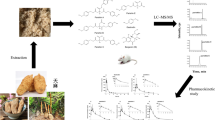Abstract
A sensitive, rapid, and robust ultra-high performance liquid chromatography-tandem mass spectrometry (UHPLC-MS/MS) method was established for the first time to quantify agarotriose (A3) in rat plasma, tissues, urine, and feces. A3 and stachyose (internal standard) were separated by a BEH amide column at 65 °C under the mobile phase of 10 mmol L−1 ammonium acetate-acetonitrile (42:58, v/v) with 350 µL min−1. The acquisition of transitions was carried out in multiple reaction monitoring (MRM) pattern operating with positive ionization at m/z 509.16 ≥ 329.15 for A3 and m/z 689.15 ≥ 527.11 for stachyose. The linearity ranges of A3 were 10 to 5000 nmolL−1 for plasma, 20 to 10000 nmolL−1 for tissues, and 40 to 20000 nmolL−1 for urine and feces. The accuracy and precision ranged from 90.9% to 111.6% and 0.7% to 10.1%, respectively. The stability was between 86.1% and 102.5%. The extraction recovery was consistent and reproducible. The matrix effect ranged from 1.5% to 11.4%. The pharmacokinetic, tissue distribution, and excretion studies were successfully conducted with the validated method. Results showed that A3 could be absorbed by rats, and the absolute bioavailability was 6.7%. Furthermore, it was rapidly distributed in rat tissues and mainly eliminated via feces excretion (67.0%) after oral administration. For intravenous bolus, 85.5% was recovered, and renal excretion was the primary pathway (77.6%) for cumulative recovery.
Similar content being viewed by others
References
Gao, B., Li, L., Wu, H., Zhu, D., Jin, M., Qu, W., et al., 2019. A novel strategy for efficient agaro-oligosaccharide production based on the enzymatic degradation of crude agarose in flammeovirga pacifica WPAGA1. Frontiers in Microbiology 10: 1231.
Harms, P. G., and Ojeda, S. R., 1974. A rapid and simple procedure for chronic cannulation of the rat jugular vein. Journal of Applied Physiology, 36: 391–392.
Higashimura, Y., Naito, Y., Takagi, T., Mizushima, K., Hirai, Y., Harusato, A., et al., 2013. Oligosaccharides from agar inhibit murine intestinal inflammation through the induction of heme oxygenase-1 expression. Journal of Gastroenterology, 48: 897–909.
Kailemia, M. J., Ruhaak, L. R., Lebrilla, C. B., and Amster, I. J., 2014. Oligosaccharide analysis by mass spectrometry: A review of recent developments. Analytical Chemistry, 86: 196–212.
Kazlowski, B., Pan, C. L., and Ko, Y. T., 2008. Separation and quantification of neoagaro- and agaro-oligosaccharide products generated from agarose digestion by beta-agarase and HCl in liquid chromatography systems. Carbohydrate Research, 343: 2443–2450.
Kazlowski, B., Pan, C. L., and Ko, Y. T., 2015. Monitoring and preparation of neoagaro- and agaro-oligosaccharide products by high performance anion exchange chromatography systems. Carbohydrate Polymers, 122: 351–358.
Kim, H. T., Yun, E. J., Wang, D., Chung, J. H., Choi, I. G., and Kim, K. H., 2013. High temperature and low acid pretreatment and agarase treatment of agarose for the production of sugar and ethanol from red seaweed biomass. Bioresource Technology, 136: 582–587.
Kim, J. H., Yun, E. J., Yu, S., Kim, K. H., and Kang, N. J., 2017. Different levels of skin whitening activity among 3,6-an-hydro-1-galactose, agarooligosaccharides, and neoagarooligosaccharides. Marine Drugs, 15: 321.
Lee, C. H., Kim, H. T., Yun, E. J., Lee, A. R., Kim, S. R., Kim, J. H., et al., 2014. A novel agarolytic beta-galactosidase acts on agarooligosaccharides for complete hydrolysis of agarose into monomers. Applied and Environmental Microbiology, 80: 5965–5973.
Lee, W. K., Lim, Y. Y., Leow, A. T., Namasivayam, P., Ong Abdullah, J., and Ho, C. L., 2017. Biosynthesis of agar in red seaweeds: A review. Carbohydrate Polymers, 164: 23–30.
Marinho-Soriano, E., and Bourret, E., 2005. Polysaccharides from the red seaweed Gracilaria dura (Gracilariales, Rhodophyta). Bioresource Technology, 96: 379–382.
Paradkar, A. and Bakliwal, B., 2008. Biopharmaceutics & pharmacokinetics. In: Drug Absorption. 2: 1–32.
Sonawane, S. S., Chhajed, S. S., Attar, S. S., and Kshirsagar, S. J., 2019. An approach to select linear regression model in bioanalytical method validation. Journal of Analytical Science and Technology, 10: 1.
Thrivikraman, K. V., Huot, R. L., and Plotsky, P. M., 2002. Jugular vein catheterization for repeated blood sampling in the unrestrained conscious rat. Brain Research Protocols, 10: 84–94.
Volpi, N., and Linhardt, R. J., 2010. High-performance liquid chromatography-mass spectrometry for mapping and sequencing glycosaminoglycan-derived oligosaccharides. Nature Protocols, 5: 993–1004.
Yun, E. J., Yu, S., Kim, Y. A., Liu, J. J., Kang, N. J., Jin, Y. S., et al., 2021a. In vitro prebiotic and anti-colon cancer activities of agar-derived sugars from red seaweeds. Marine Drugs, 19: 213.
Yun, E. J., Yu, S., Park, N. J., Cho, Y., Han, N. R., Jin, Y. S., et al., 2021b. Metabolic and enzymatic elucidation of cooperative degradation of red seaweed agarose by two human gut bacteria. Scientific Reports, 11: 13955.
Zhang, Q., Guan, J., Li, S., Zhao, Y., and Yu, Z., 2017. Application of an UHPLC-MS/MS method to tissue distribution and excretion study of 2-(2-hydroxypropanamido) benzoic acid in rats. Journal of Chromatography B: Analytical Technologies in the Biomedical and Life Sciences, 1070: 54–61.
Acknowledgements
This study was funded by the Fundamental Research Funds for the Central Universities (Nos. 201912008, 2019 64019), and the Natural Science Foundation of Shandong Province (No. ZR2019BC025).
Author information
Authors and Affiliations
Corresponding author
Rights and permissions
About this article
Cite this article
Yue, J., Cheng, W., Wei, S. et al. Development and Validation of UHPLC-MS/MS Method for Quantifying of Agarotriose: An Application for Pharmacokinetic, Tissue Distribution, and Excretion Studies in Rats. J. Ocean Univ. China 22, 1683–1691 (2023). https://doi.org/10.1007/s11802-023-5534-4
Received:
Revised:
Accepted:
Published:
Issue Date:
DOI: https://doi.org/10.1007/s11802-023-5534-4




